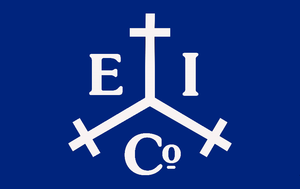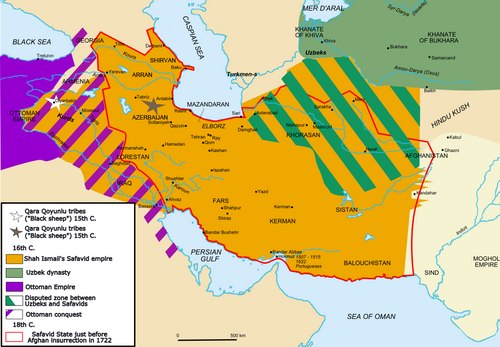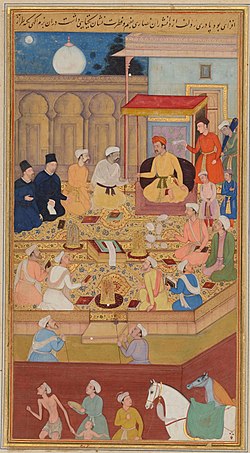Topic 4.5 Maritime Empires Maintained and Developed
In the early 1600s European countries found new methods of financing exploration and business. Since trading ventures were too expensive for most individuals to fund, investors began to pool their resources together into organizations called joint-stock companies. The most famous of these, the British East India Company (EIC), began in 1600 when the British government gave 218 London investors a royal monopoly of all trade east of the Cape of Good Hope. Established about one year later was the Dutch East India Company, known

as the VOC. They were initially a much larger and wealthier rival of the EIC, with 10 times the capital resources of its British counterpart. Joint-stock companies proliferated. The Dutch West Indies Company traded in the New World and founded New Amsterdam, today New York City. And the Virginia Company of London was given a monopoly on the mid-Atlantic coast of North America.
Joint-stock companies were

an improvement over traditional partnerships because of something called limited liability. In a partnership, investors pool their resources together and share the profits or losses collectively. In the case of a shipwreck or some other calamity, however, investors would owe more than they put in and could be driven to bankruptcy. But the limited liability of a joint-stock company meant that an investor could never lose more than what he paid in. With risks thus limited but the potential for profit still high, joint-stock companies attracted thousands of investors willing to put up money, called stock, in these ventures.
Voyages funded by joint-stock companies were more efficient and profitable than those funded by monarchs. Unconcerned with religious conversion, their voyages were streamlined to produce as much profit as possible in order to please investors and attract more capital. Thus countries such as Spain and Portugal, in which the king financed business, could not compete with the more efficient business practices of companies. Spain endured only as long as it could drain the New World of its silver reserves.
Since

the classical age several major trade routes dominated trans-regional trade. Political, environmental and demographic changes altered the ebb of flow in the volume of trade and gave each a turn at being the dominant trade route. These major routes coexisted for most of this time and no major new networks were added. Between 1450 and 1750, however, an entirely new trade route emerged and became the world's dominant network of exchange. The Atlantic System connected the old and new worlds in a triangular pattern across the ocean. A truly global system of trade was established.
In an effort to make trade as efficient as possible, ships in this triangular pattern never sailed empty. From Africa, they sailed across the Atlantic to the New World with slaves. After selling the slaves, they sailed to Europe with sugar, tobacco, and rum. After loading their ships with alcohol, metal items, and guns, they said to Africa's west coast to trade these things for slaves and begin the circuit all over again.
We

saw in the previous period (600-1450) that the creation of a common currency in China facilitated trade in that region. Widely accepted currencies speed up transactions and provide standardized way for merchants to measure the value of products. In this period the use of a common currency expanded from regional to global use. The Spanish peso de ocho, or "piece of eight," was the first currency in history to be used globally.
This currency was the product of Spain's mining of enormous amounts of silver in the New World. In present day Bolivia and Mexico, they discovered massive deposits of silver, including a mountain full of silver at Potosi. After the purest veins of silver were quickly strip-mined production slowed; then the

Spanish introduced the amalgamation method of using mercury to extract silver from ore. Production soared. In two centuries the silver mines of the Spanish New World produced 40,000 tons of silver. [1] The industrial centers that grew around these mines minted 2.5 million silver coins per year. The peso de ocho, worth about 80 US dollars today, gained acceptance around the world and lubricated global trade on an unprecedented level. Mughal India wanted Spanish silver for payment for its pepper sales, and this surge of silver funded Shah Jahan's construction of the Taj Mahal. Much of the Spanish silver ended up the hands of the Chinese, who had no desire for European products but readily accepted silver as payment for its coveted exports. The peso do ocho was even accepted currency in the United States until the Coinage Act of 1857. [2]
The increase in interactions between newly connected hemispheres and intensification of connections within hemispheres expanded the spread and reform of existing religions and created syncretic belief systems and practices.


Islam Between 1450 and 1750 Islam continued to advance. As it did, it blended with local cultures and practices. One of the most obvious examples of this blending was the Byzantine influence on Ottoman architecture after the Ottomans took Constantinople in 1453. They drew upon the knowledge of Byzantine architectural guilds for their domed mosques and adopted the practice of marble masonry and mosaics. The Ottomans improved these techniques to create greater spacial interiors and more expansive domes. Another notable blending of culture was the building of the Faith Mosque on the site of the former Christian Church of the Holy Apostles, which had been destroyed in the Fourth Crusade. This Church had been the burial site for Byzantine Emperors, and Mehmed II chose this same spot for his tomb, adopting the titles of both Sultan and Caesar of Rome.[3] In doing so, Mehmed laid claim to political legitimacy before his Muslim and non-Muslim populations.
Islam blended with local cultures in Southeast Asia as well. The prophet Mohammed showed up as a character in Hindu epics and local folklore. [4] In Indonesia, the selamatan, a local feast of reconciliation, was used by Muslim leaders to convert people to the new faith. Conversion stories took on traditional characteristics, such as accompanying miracles and signs. In Javanese culture, these miracles were necessary to establish the leader as a channel of communication between God and people. [5] As the Islamic Mughal Dynasty formed in South Asia, an enormous amount of religious syncretism formed. A new world religion, Sikhism, combined Islam's notion of the oneness of God with the Hindu concept of inclusiveness. Although it did not endure, Akbar attempted to create a new faith by combining elements of Hinduism, Islam, Christianity and Zoroastrianism. In the arts, Persian, Hindu and Muslim styles blended to form a distinctively Mughal form of painting.
The Sunni-Shia divide in Islam that emerged in the previous time period grew more intense in this era. The epitome of this conflict was the struggle between the Ottoman Empire, which was Sunni, and its Shia neighbor, the Safavid Empire. The territorial struggle between these two Muslim empires culminated with the Battle of Chaldiran i

n 1514. At this battle in present day Iran, the outnumbered and poorly equipped Shia Safavids were defeated by the Sunni Ottomans. Firearms were a prominent reason for the Ottoman victory and they experienced a period of expansion after the Battle. The Safavids learned the importance of firearms and became a "gunpowder empire." More importantly, the spread of Shia Islam was stopped and this sect continued as a minority sect of the Muslim religion.
A major force in the spread of Islam during this era was Sufism. This sect of Islam emphasized the experiential and mystical approach to God over formal practices and creeds. Sufis sought emotional encounters that brought them into union with God. Organized into Orders, each group had is own habits and rules and usually formed around a charismatic holy man. Sufism served to spread Islam in two ways; because they begged for food and did not own homes, Sufis were wandering mystics and became de fact missionaries. Secondly, their emphasis on experience rather than doctrines allowed them to adapt to many host cultures and form syncretic belief systems. [6] In Southeast Asia, for example, Sufis were accepted by the Hindu Bhaktis who had their own tradition of experiential religion. Thus Sufism was absorbed into a wider devotional movement that transcended religious faiths. [7] In West Africa, where Sufi Orders became important institution in African society, Sufism became an essential element of Islam's spread and integration. In these Orders, Sunni and Shia Muslims, heretics, and traditional spiritualists all came together. Sufi mystics were often well versed in Islam as well as in the spiritual ways of traditional

African religions. [8] Consequently, it is not surprising that Islam in West Africa tended to remain highly syncretic. Sunni Ali, the founder of the Songhai Empire, claimed to be a Muslim but continued to practice traditional religious rituals and sacrifices and sought legitimacy through them. [9]
Christianity In this era Christianity became more diversified and spread across the globe. The impetus for these changes began in Western Europe where the unity of Christian civilization was shattered by the Protestant Reformation. The printing press made the Bible available to countless Christians, and many of them took it to be a higher authority in their lives than the Pope and hierarchy of the Roman Catholic Church. Believers who "protested" the church and broke from Catholicism became known as Protestants. Owing to their belief that Christians can read and interpret the Bible for themselves, Protestants quickly splintered into many subgroups based on varying interpretations and practices. The Protestant Reformation quickly became political as some European monarchs left the Catholic Church only to free themselves from the Pope's authority and become more autonomous.
The Catholic Church responded to the Protestant Reformation with the Council of Trent, a large meeting in which they affirmed their Catholic beliefs, answered criticisms of Protestants, and reformed some Catholic practices. From a global perspective, the most important impact of the Council of Trent was the decision to convert people in newly discovered and accessible lands to the Roman Catholic faith. The Order of Jesuits was created for this missionary purpose. After intense training in philosophy, theology, and survival, Jesuits went out across the globe seeking converts and often endured severe hardships and even executions. Despite their zeal, they had little success in Asia except for the northern Philippines which remains predominately Catholic to this day. The Jesuits had much

more success in Latin America. In Brazil, they organized people into villages, built schools for children, and created a writing system for the local languages. [10] The seventeenth century saw an increase of Jesuit missionary activity across Latin America. They set up missions in Peru, Colombia, Venezuela and Bolivia. As early as 1603 there were 345 Jesuit priests in Mexico alone. [11]
Syncretism in the Americas The spread of religion in this era led to rich syncretic blends of religious symbolism and beliefs. We have already mentioned the development of Sikhism above. In the Americas, the Jesuits and other Catholic missionaries were often disappointed with their attempts to spread their faith to the Amerindians who imbued Christian symbols with their own traditional beliefs. The best example of this blending is the cult of the Virgin of Guadalupe, the patron saint of Mexico today. In 1531 a peasant reported seeing a vision of the Virgin Mary to his local priest. The site of this apparition was a hill used to worship the Aztec fertility god Tonantzin in pre-Columbian times. The Spanish had previously destroyed the temple to Tonantzin on this very hill and replaced it with a Catholic church, a common practice in the conquest of Mexico. According to reports, when an image of this vision was first unveiled at this church peasants did not recognize it as the Virgin Mary but instead shouted "Tonantzin! Tonantzin!" [12] One of the Aztec titles for Tonantzin was "Seven Flowers," [13] an interesting fact when we see that the Virgin of Guadalupe is frequently depicted amidst an abundance of flowers. Thus in Latin America is it less accurate to speak of "conversion" than of the rise of a genuinely mestizo religion in which indigenous people projected ancient forms of worship onto the symbols of the new Catholic faith. [14]
A similar process occurred in the Caribbean. The indigenous population of Haiti (Hispaniola) was almost entirely wiped out by disease and conquest and replaced by French Catholics and African slaves. Ironically, Catholic authorities in Haiti accelerated the process of syncretism by forbidding slaves from worshipping their former African deities. Slaves adapted by using Catholic saints as representatives of their closest African counterparts. In worshiping the Virgin Mary, Africans were actually worshiping Oshun, the beautiful Nigerian water goddess of love. They continued their worship of Legba, the god who holds to keys to the underworld and decides people's eternal destiny, by paying their respects to Saint Peter. [15] By appropriating Catholic saints and images to their own beliefs, slaves in Haiti could use them as "a veil behind which they could practice their African religions." [16] The resulting syncretic religion that came out of this practice is known as Vodun. Although often misunderstood in popular culture (sometimes called Voodoo), it is a rich and varied belief system containing a system of justice, folk medical practices, oral and artistic traditions, and creeds. The religion of Santeria in Cuba developed similarly by blending the beliefs of Yoruba slaves with Spanish Catholicism.
- ↑ Silver, Trade, and War: Spain and America in the Making of Early Modern Europe, (2000), Stanley J. Stein, Barbara H. Stein, p. 21.
- ↑ http://memory.loc.gov/cgi-bin/ampage?collId=llsl&fileName=011/llsl011.db&recNum=184
- ↑ Encyclopedia of the Ottoman Empire. (2009), Ga ́bor A ́goston, Bruce Alan Masters, p. 216.
- ↑ Islam in South Asia in Practice. (2009),Barbara Metcalf, p. 104.
- ↑ Islam in South Asia in Practice, p. 105.
- ↑ The Spread of Islam: The Contributing Factors, (2002) Abū al-Faz̤l ʻIzzatī, A. Ezzati, p. 164.
- ↑ Islam in South Asia in Practice, p. 93, 105.
- ↑ The Spread of Islam: The Contributing Factors, p. 164.
- ↑ The Islamic World. (2013), Andrew Rippin, p. 27.
- ↑ The History of the Church in Latin America. (1981), Enrique Dussel, p. 59.
- ↑ The History of the Church in Latin America, p. 60.
- ↑ The Virgin of Guadalupe: Theological Reflections of an Anglo-Luthern Liturgist. (2002), Maxwell E Johnson, p. 57.
- ↑ https://www.princeton.edu/~achaney/tmve/wiki100k/docs/Tonantzin.html
- ↑ Our Lady of Guadalupe: The Origins and Sources of a Mexican National Symbol, 1531-1797 (1995), Stafford Poole, p. 79.
- ↑ Sacred Possessions: Vodou, Santeria, Obeah, and the Caribbean (1997), Margarite Fernández Olmos, Lizabeth Paravisini-Gebert, p. 5.
- ↑ Cited in Sacred Possessions: Vodou, Santeria, Obeah, and the Caribbean (1997), p. 5.